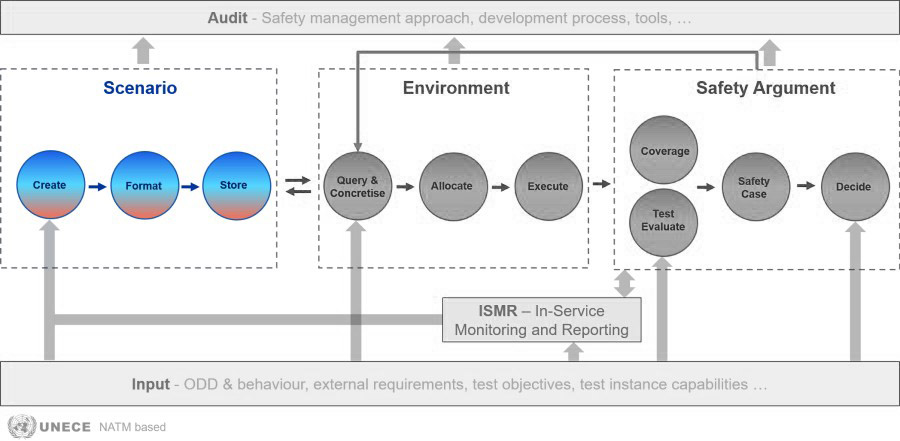
The Scenario block focuses on managing scenarios critical for safety assurance, encompassing three key processes: creation, formatting, and storage.
- Create involves generating scenarios based on data-driven or knowledge-driven approaches. Scenarios are derived using methodologies like StreetWise, which extracts real-world scenarios and statistics from driving data, or database like Safety Pool™, which leverage various scenario generation methods. These processes occur within individual scenario databases (SCDBs), reflecting database-specific requirements and use cases. While scenario creation is handled independently by SCDB providers, it is integral to the overarching safety assurance framework.
- Format structures scenarios into appropriate representations for effective communication and downstream testing. Multiple levels of abstraction are employed to cater to diverse stakeholders, ranging from human-readable functional and abstract-level scenarios to machine-readable logical and concrete-level scenarios. Common formats like ASAM OpenSCENARIO, OpenDRIVE, and BSI Flex 1889 ensure interoperability and standardization.
- Store consolidates formatted scenarios within SCDBs, enabling seamless access and integration. The SUNRISE project introduces the SUNRISE Data Framework to link multiple SCDBs, requiring database owners to adhere to shared formats and abstraction levels to connect. This federated approach ensures unified access while maintaining flexibility for individual database management.
Together, these processes enable a structured, standardized, and scalable approach to scenario management for Cooperative Connected Automated Mobility (CCAM) system safety assurance.
Audit instructions for 'Scenario'
By following the steps indicated below, a user of the SUNRISE SAF can audit the contents of the Scenario block. These steps aim to audit the overall characteristics and properties of the scenario database, and do not consider the actual content of individual test cases (which is part of the Execute block). Note that the Scenario sub-blocks (Create, Format and Store) are the responsibility of the scenario database owner and therefore not further elaborated in the SUNRISE SAF. For that same reason, auditing steps will not be specified for individual sub-blocks, and apply only to the overarching Scenario block.
- Check Standardization Compliance
- Verify that the scenario databases follow standardized formats for storing scenarios (D3.2 Section 7.1)
- Confirm alignment with data exchange and testing standards (D6.1 Section 2.6)
- Verify Source Documentation
- Check that scenarios in the database include source information (D3.2 Section 4.2.3, Requirement A.3)
- Validate that sources are properly documented with data or expert knowledge origin (D3.2 Section 4.2.3, 8.1.1)
- Evaluate Database Extension Capabilities
- Verify the database supports extensible parameter lists (D3.2 Section 5.5.2, Requirement H.2)
- Ensure the database can accommodate new parameters. For example when standards or protocols are updated. (D3.2 Section 5.5.2, 8.2.4)
- Verify Database Search Functionality
- Confirm the database supports searching/querying using tags (D3.2 Section 4.2.2, Requirement A.2)
- Review Data Accuracy (D5.3 Section 4.2.2)
- Assess the correctness of data entered into the scenario database
- Cross-reference with known benchmarks or references
- Verify that scenarios reflect real-world conditions accurately
- Review Data Consistency (D5.3 Section 4.2.2)
- Check for uniformity across all scenarios in:
- Units of measurement
- Data formats
- Terminologies used
- Standardized naming conventions
- Check for uniformity across all scenarios in:
- Check Data Freshness (D5.3 Section 4.2.2)
- Check how up-to-date the scenarios are
- Verify current relevance of the database content
- Check last update timestamps
- Check Number of Scenarios (D5.3 Section 4.2.2)
- Count total distinct scenarios available
- Obtain overview of database comprehensiveness
- Check scenario quantity metrics
- Check Covered Kilometres (D5.3 Section 4.2.2)
- Check on how many Km’s the scenario database is based
- Assess span and scale of included scenarios
- Quantify geographic coverage
- Verify Scenario Distribution (D5.3 Section 4.2.2)
- Analyse breakdown of scenarios by:
- Geographic regions
- Road types
- Weather conditions
- Time of day
- Traffic density
- Analyse breakdown of scenarios by:
- Verify Scenario Complexity (D5.3 Section 4.2.2)
- Assess difficulty levels across scenarios considering:
- Number of vehicles involved
- Presence of pedestrians
- Road complexity
- Environmental conditions
- Assess difficulty levels across scenarios considering:
